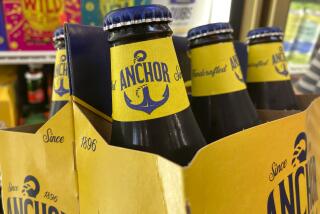Thinking Small Pays Off for Anchor Steam Brewer
SAN FRANCISCO — Fritz Maytag, heir to part of the fortune his family made selling washing machines, took some of the money he inherited and cleaned up in the beer business.
Anchor Brewing Co., which Maytag saved from bankruptcy in 1965, has gathered an almost spiritual following in its San Francisco home, as well as a steady stream of admirers among beer lovers in the 30 states where it’s sold.
When Maytag bought the brewery, it suffered from lackluster sales and inconsistent product. Maytag set about to find out what was wrong.
“I brought in my microscope that I had as a boy,” the entrepreneur says. “I read a few books and I knew what to look for. And I found it. It was spoiling.”
Maytag, 47, blamed bacteria roaming in the brew for spoiling the beer.
“I had this feeling, and I can still feel it in my bones,” Maytag recalls. “I wanted to get down to the beginning and start right.”
By 1971, Maytag was bottling Anchor Steam beer, which had previously been available only in kegs. By 1975 the company was turning a profit. His tiny brewery, with just 14 full-time employees, is thriving. Anchor produces only 410,000 cases of beer and ale a year, while a giant such as Anheuser-Busch Co. sells 880 million cases annually.
Competes With Imports
But Anchor competes effectively with popular imported brands such as Heineken, Maytag says, and he’s making a healthy profit now, although he won’t say how much.
He set out to create a super-premium beer that would appeal to a sophisticated drinker, a move that limited his market. He also decided not to advertise, concentrating instead on producing a quality product and assuming--correctly, it turned out--that his venture would generate enough attention.
And Maytag took the title of brew master for himself, even though he had no experience making beer. “I feel I have earned it,” says Maytag. The title, he says, serves as “a kind of reminder that I’m in charge of what we’re making.”
While he’s a hard taskmaster when it comes to making beer, Maytag maintains a relaxed atmosphere at the brewery. The start of a shift is often marked by workers sharing a cold draft in a tasting room decorated with memorabilia of malt beverages.
Employees wear beepers around the converted coffee plant that serves as Anchor’s headquarters and often are summoned to pitch in around the building. Such is life at a small business, but Maytag likes it and doesn’t want to get much bigger.
“Something happens when you get too many people in an organization,” he says. “All of a sudden you get people thinking in terms of them, rather than us . . . Somehow the idea of might and force and size has never appealed to me.”
Maytag, who uses the best hops he can find and adds nothing artificial, will take some credit for being part of a shift in the food and beverage industry toward better quality ingredients.
One big question: How did steam beer get its name? No one, including Fritz Maytag, really knows.
In the 19th century, the term steam beer is believed to have been used as a nickname for draft beer brewed without ice and may refer to the pressure of carbonation released when the kegs were tapped.
Steam was also used in the early days of the U.S. beer industry to heat brewing vessels and even pasteurize bottled beer. There’s even a legend that a man named Pete Steam brewed beer in California during the gold rush.
More to Read
Inside the business of entertainment
The Wide Shot brings you news, analysis and insights on everything from streaming wars to production — and what it all means for the future.
You may occasionally receive promotional content from the Los Angeles Times.










